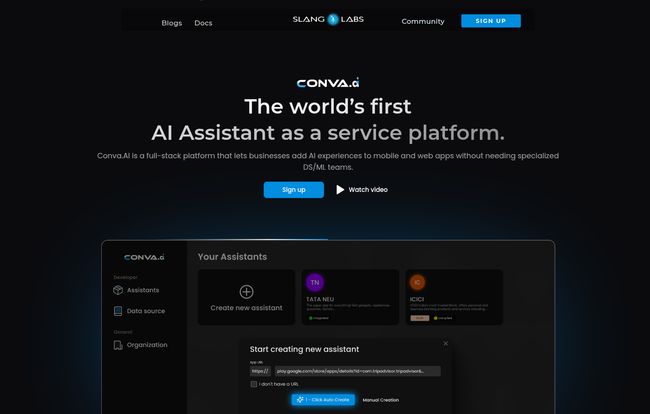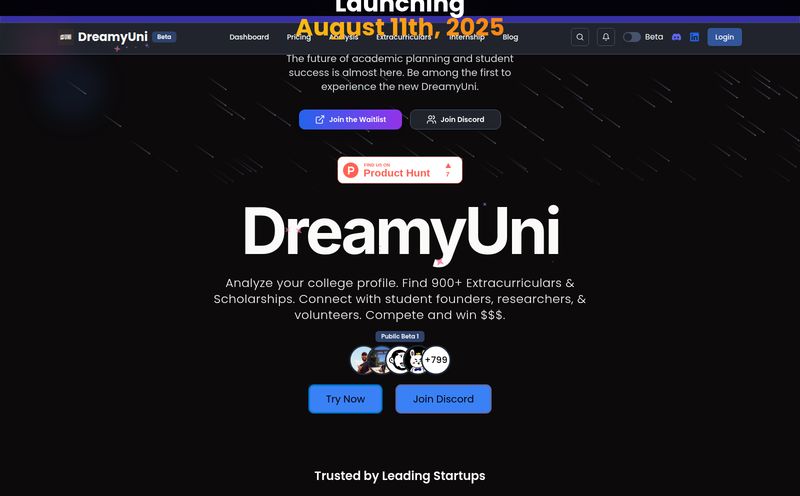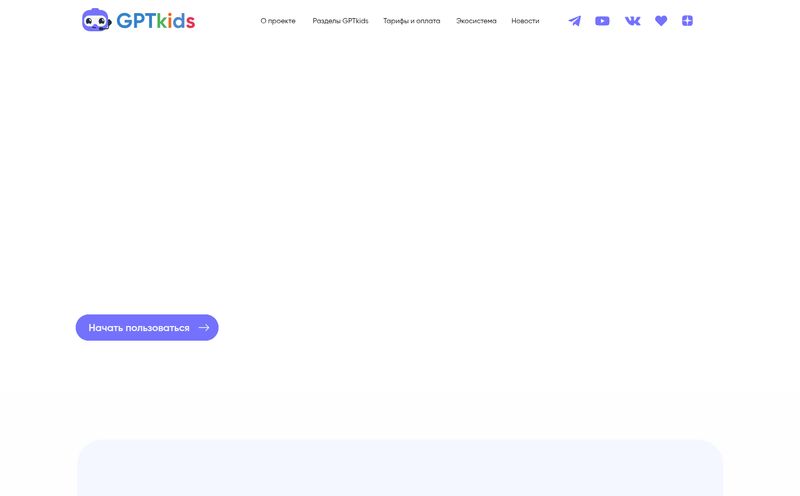Everyone wants it. Your users are starting to expect it. And your competition is probably already shipping it. But here’s the rub: integrating meaningful, genuinely helpful AI into an app is… hard. Like, really hard.
It's a resource black hole. You need specialized Machine Learning engineers, who are not easy to find or cheap to hire. You need data scientists. You need endless development cycles, wrestling with complex frameworks and finicky prompts. The gap between a product manager’s brilliant idea and a functioning in-app AI assistant can feel like the Grand Canyon.
So when a platform comes along promising “AI without the Drama,” my ears perk up. That’s the bold claim from Conva.AI, a platform that calls itself the “world’s first AI Assistant as a Service.” It’s a pretty gutsy statement, but after digging in, I think they might be onto something big.
So, What Exactly is Conva.AI?
Let's cut through the marketing jargon. Conva.AI is a low-code platform designed to help you build and plug a smart AI assistant directly into your existing mobile or web app. The team behind it, Slang Labs (who are backed by some of the folks who originally created Google, which is a heck of a resume), came up with a fantastic analogy: they call it "Firebase for AI."
If you've ever done any app development, that phrase probably just made you sit up a little straighter. Firebase was a game-changer because it took all the messy, complicated backend stuff—authentication, databases, hosting—and turned it into a simple, manageable service. It let developers focus on building a great user experience instead of reinventing the wheel on server architecture.
Conva.AI aims to do the exact same thing for in-app artificial intelligence. It abstracts away the complexity of managing large language models (LLMs), orchestrating data sources, and handling context so your team can focus on designing a killer AI experience.
Ditching the Drama: How It All Works
From what I've gathered, the magic of Conva.AI isn't a single thing but a combination of three core components working in harmony. It's less of a black box and more of a well-organized toolkit.
The Magic Studio: Where the Ideas Happen
This is their web-based console, and frankly, it's the part that gets me most excited. This is where you define what your AI assistant can do. But it's not just for engineers. The whole point is that product managers, UX designers, and even copywriters can get in here and prototype AI behaviors using what they call "meta-prompts." It fosters collaboration, which is huge. It means the people with the vision for the product can actually build and test that vision without having to write a 50-page spec doc and wait six months.

Visit Conva.AI
The SDK: The 'Plug' for Your 'Play'
The Platform Specific SDK (Software Development Kit) is the bridge between your app and the Conva.AI brain you built in the Magic Studio. It’s the piece of code your developers drop into your app. The goal here is simplicity. Instead of a months-long integration project, it’s designed to be much more straightforward, letting you get the AI assistant up and running with minimal fuss.
The Orchestrator: The Conductor of the AI Symphony
This is the real secret sauce. The Orchestrator is the runtime component that intelligently figures out what to do with a user's request. It’s not just passing a query to a generic LLM. It's looking at the context of the app, pulling from different data sources you've defined, and using various tools to get the right answer or trigger the right action. It’s the difference between a dumb chatbot and a genuinely helpful assistant.
More Than Just a Fancy Chatbot
I think we all have a bit of fatigue from basic chatbots that can only answer from a pre-written script. That's not what this is. Conva.AI is positioned to go way beyond that. Think about an e-commerce app like Nykaa (one of their listed clients). A user could ask, "Show me vegan, cruelty-free lipsticks under ₹1000 that would suit a warm skin tone."
A simple bot would collapse. But an assistant powered by Conva.AI could theoretically:
- Provide answers: Understand the keywords "vegan," "cruelty-free," and the price constraint.
- Trigger actions: Apply those filters directly to the product search within the app.
- Generate dynamic content: Offer personalized recommendations based on the user's past purchase history or browsing context.
And it does all this with multi-lingual and multi-modal (voice and text) support from the get-go. For a company operating in a diverse market like India, where many of their clients (redBus, Myntra, Medibuddy) are based, this isn't just a nice-to-have; it's essential.
Conva.AI vs. The World (Okay, Mainly LangChain)
On their own website, Conva.AI makes a direct comparison to LangChain, which I find both bold and incredibly helpful. They're not afraid to define their lane. For those who aren't in the weeds, LangChain is an amazing open-source framework for developers building with LLMs. It’s a set of powerful, low-level tools—the raw ingredients and a professional chef's knife set.
Conva.AI is the high-end meal kit. It has all the prepped ingredients, the recipe card, and the specialized tools you need, all in one box. It’s designed for the whole kitchen team—the chef (engineer), the menu planner (product manager), and the food stylist (designer)—to work together efficiently.
In my experience, many AI projects die in the translation between what the product team wants and what the engineering team can realistically build in a given timeframe. A platform like Conva.AI aims to build a bridge across that valley of death. That's a powerful value proposition.
The Good, The Bad, and The... 404 Page
Alright, let's get down to brass tacks. No tool is perfect, and as an SEO and product guy, I always look for the catch.
The Good Stuff is pretty clear: It dramatically simplifies a very complex process. It speeds up time-to-market for AI features and fosters genuine collaboration between technical and non-technical teams. For a startup or even a larger company that wants to innovate faster, this is gold.
The Potential Downsides are also worth considering. First, there's the classic platform lock-in. When you build your AI logic on Conva.AI, you're reliant on them. Migrating away would likely be a significant undertaking. Second, while low-code is great for 90% of use cases, there will always be that 10% of truly unique, boundary-pushing AI features that might require building from scratch with something like LangChain. You trade some ultimate flexibility for speed and simplicity.
And then there's the pricing. Or, the lack thereof. I clicked around their site, eager to see their pricing tiers, and was met with a... 404 Page not found. As a professional trying to evaluate a tool, hitting a dead end on the pricing page is a bit of a bummer. It's an unforced error. This usually suggests a 'contact us for a custom quote' enterprise model, which is fine, but the lack of transparency is a small hurdle. I hope they fix that little issue soon.
Who Should Be Looking at Conva.AI?
This isn't for the AI research scientist at a FAANG company trying to build the next foundational model. This is for the rest of us.
I see this being a perfect fit for:
- Product-led startups and scale-ups who want to integrate sophisticated AI without the astronomical cost and time sink of building an in-house ML team.
- Established companies looking to streamline how they develop and deploy AI features across their product portfolio.
- Product Managers and Designers who are tired of their brilliant AI concepts getting lost in translation or stuck in a year-long engineering backlog.
My Final Take
Despite the mysterious 404 page, I’m genuinely impressed with the thinking behind Conva.AI. They have correctly identified one of the biggest bottlenecks in modern product development. The focus on collaboration and the “Firebase for AI” approach isn’t just clever marketing; it’s a smart product strategy.
It represents a shift from seeing AI as a purely engineering problem to viewing it as a product experience problem. By giving the whole team a seat at the table, Conva.AI has the potential to help a lot of companies finally deliver on that promise of building smarter, more helpful, and more engaging applications. If you're in that boat, it's definitely worth sending them a message to get a demo. Just don't try to find the pricing page on your own.
Frequently Asked Questions (FAQ)
Q1: What is Conva.AI in simple terms?
Conva.AI is an "AI Assistant as a Service" platform. It's a low-code tool that helps businesses add smart, conversational AI assistants to their mobile and web apps without needing a dedicated team of machine learning experts.
Q2: Is Conva.AI a no-code platform?
It's best described as a low-code platform. While product managers and designers can define the AI's behavior in the "Magic Studio" without writing code, developers are still needed to integrate the platform's SDK into the app itself. The heavy lifting of AI is handled, but some coding is required for the final connection.
Q3: Who is the ideal user for Conva.AI?
It's ideal for product teams—including product managers, designers, and engineers—at startups or established companies who want to quickly implement in-app AI features. It's designed for those who want to focus on the user experience rather than the underlying AI infrastructure.
Q4: How is Conva.AI different from a standard chatbot builder?
Standard chatbots often follow rigid scripts. Conva.AI is designed to be much more dynamic. Its Orchestrator can understand app context, connect to multiple data sources, and trigger in-app actions, making it a true assistant rather than just a Q&A bot.
Q5: What is the pricing for Conva.AI?
As of this writing, the pricing information is not publicly available on their website; the pricing page leads to an error. This typically indicates a custom or enterprise pricing model. You would need to contact the Conva.AI team directly for a quote.
Q6: Can Conva.AI handle multiple languages?
Yes, the platform is built with multi-lingual support, allowing you to create AI assistants that can serve a global or linguistically diverse user base.



